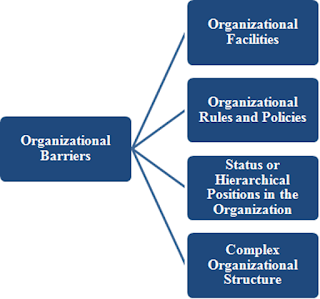Barriers refer to the disturbances in the process of communication. They are also called as Noise.
There are four types of barriers.
- Semantic Barriers
- Organisational Barriers
- Psychological or Emotional Barriers
- Personal Barriers
Semantic Barriers
The Semantic Barriers refer to the misunderstanding between the sender and receiver due to the different meanings of words or other symbols used in the communication.
The semantic barriers usually arise when the message is not in the simple language and has words or symbols that have multiple meanings.
The semantic barriers can arise due to
- Symbols or words with different meanings
- Faulty translation
- Bad expression of message:
- Denotations and Connotations
- Technical jargons
- Un-clarified Assumptions
1.Symbols or Words with Different Meanings
Same words may convey different meanings to different people. People interpret words and symbols in terms of their own experience and thinking.
- That bird is a crane.
- They had to use a crane to lift the object.
- She had to crane her neck to see the movie.
- I enjoyed watching a clip from that video.
- My mom is going to clip my hair.
- The boat is moving at a fairly fast clip.
2. Faulty translation
Sometimes, the sender formulates the message as per his level of understanding irrespective of the receiver’s level of understanding.
3. Bad expression of message
The obscurity of language leads to the wrong interpretation of message.
The message is not formulated properly and the language used is so difficult that it could be misinterpreted by the receiver.
4 Denotations and Connotations
The denotation means the literal meaning of the word.
The detonation barrier occurs as the sender and receiver using a different definition and meaning of the word used in the message.
Connotation means the implied meaning of the word
The connotation barrier occurs as the people use words which have different meanings in abstract situations, contexts and feelings. Beauty, confidence are the examples of words which have implied meanings as per the context.
5. Technical jargons
Often people from technical field like technical engineers, production managers, IT managers etc. use the words from technical field in their communication which is quite difficult for the layman to understand as these words are only used in technical field.
6. Un-clarified Assumptions
Sometimes the sender assumes that the receiver may be aware of some facts and focus only on the subject matter. If these assumptions are vague and unknown to the receiver then the communication might get adversely affected.
Psychological or Emotional Barriers
The Psychological or Emotional Barriers refer to the psychological state
i.e. opinions, attitudes, status consciousness, emotions etc. of a person which affects the communication.
The Psychological or Emotional Barriers can arise due to
1. Premature Evaluation
There are some impatient people who jump to the conclusions directly and form judgments without taking into considering the various dimensions of information. This premature evaluation of the information is considered as a barrier to the effective communication.
2.Lack of Attention
When the person is absorbed in his own thoughts and does not listen carefully to the other person. In such situation, he is unable to comprehend the message and will not be able to give proper feedback.
This acts as a hindrance in the communication process.
3. Poor Retention
The retention refers to the capacity of a brain to retain or store things in the memory. The brain does not store all the information however retains which seem to be helpful in the future. Therefore, much of the information is lost during the process of retention. This acts as a hindrance in the communication process.
4.Loss by Transmission
Whenever the information is exchanged the credibility gets reduced. Mostly it is observed in oral communication where people handle information carelessly and transmits the information with loss of some facts. This acts as a hindrance in the communication process.
5. Distrust
Mutual trust is needed in effective communication. If sender and receiver don’t have trust then they will tend to derive negative meaning out of the message and often ignore the message.
This will result in a meaningless communication.
6.Emotions
The communication is greatly influenced by the emotions of a person. If a person is emotionally disturbed, he will not listen properly to whatever is said and might say things offending the sender. The emotions such as anger, nervousness, confusion, restlessness etc. affect the communication process.
Organisational Barriers
The Organisational Barriers refers to the hindrances in the flow of information among the employees that might result in a commercial failure of an organisation.
The Organisational Barriers can arise due to
1. Organisational Rules and Policies
The organisations have protocol of communication and due to the stringent rules the employees try to escape from sending any messages.
2. Status or Hierarchical Positions in the Organisation
In every organisation, the employees are employed on hierarchical positions. The communication among them would be formal. This formal communication to his superior is a barrier as he does not want to send the faulty or wrong message and decrease his credibility
3. Organisational Facilities
When the facilities like telephone, stationery, translator, Net, Laptops or computers are adequately offered to the employees then the communication is timely, accurate and according to the needs. However in the absence of such facilities, the communication may get adversely affected.
4. Complex Organisational Structure
The communication gets affected if there are a greater number of management levels in the organisation. The communication is delayed due to more levels and might change before reaching the intended receiver.







No comments:
Post a Comment